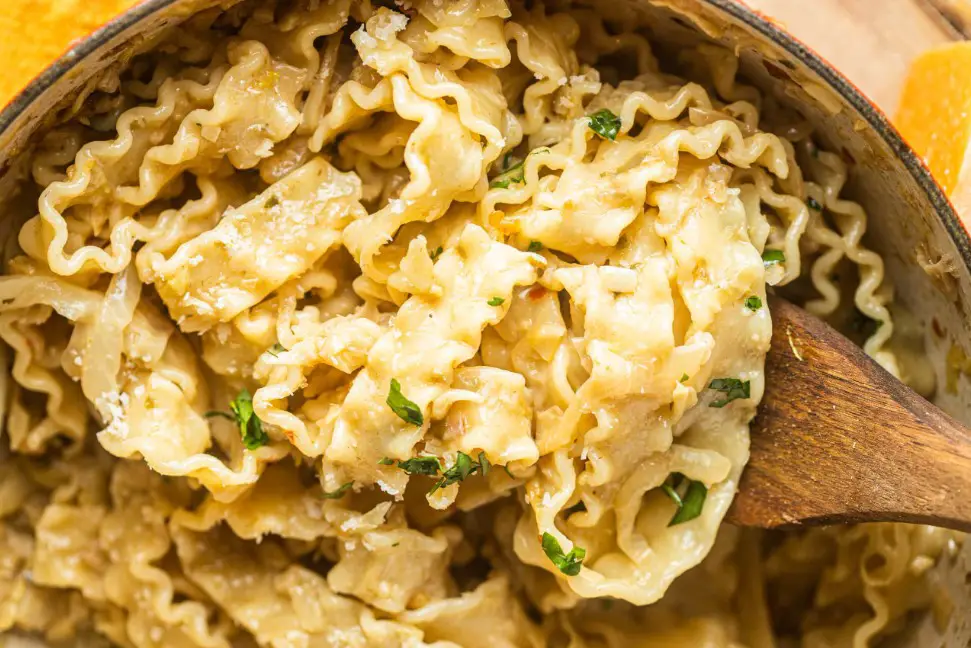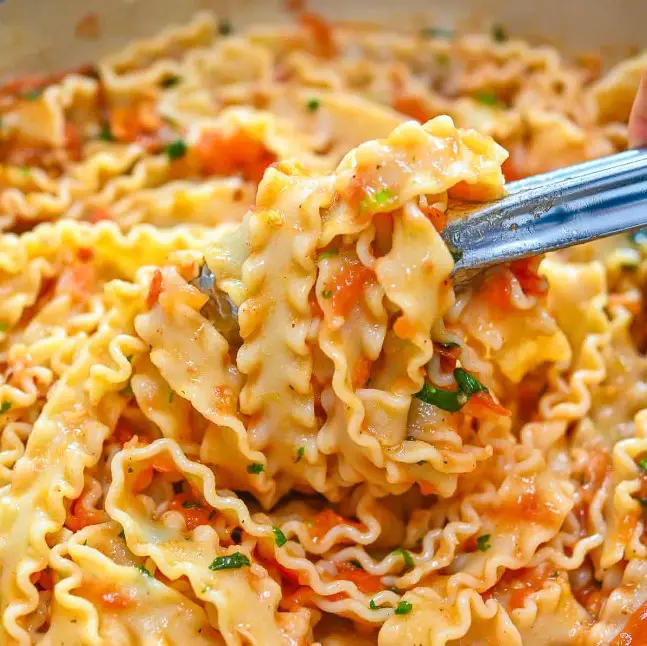History and Origin
Mafaldine pasta, a distinctive and elegant variety of pasta, has a rich history that is deeply intertwined with Italian culinary traditions. Originating from Naples, this pasta is believed to have been created in the early 20th century. Its creation is often attributed to the celebration of the unification of Italy, and some stories suggest it was specifically made to honor Queen Margherita of Savoy, the first Queen of Italy after the unification. The pasta’s regal appearance, resembling the ruffles of the queen’s dresses, is said to be a tribute to her.
The historical significance of mafaldine pasta extends beyond its royal association. It represents the rich cultural heritage of Italian cuisine and the creativity of Italian pasta makers in developing unique pasta shapes that capture both the eye and the palate. Mafaldine has stood the test of time, not only as a culinary delight but also as a symbol of Italian pride and the country’s deep-rooted love for pasta. To learn more about traditional Italian pasta varieties, visit the Italian Pasta Association.
What is Mafaldine Pasta?
Mafaldine pasta, also known as “reginette” (meaning “little queens” in Italian), is a type of ribbon-shaped pasta. It is characterized by its long, flat, and curly edges, which resemble the ruffles of a queen’s gown. This unique design is not just for aesthetic appeal; it serves a practical purpose in the culinary world. The wavy edges of mafaldine are excellent at trapping and holding onto sauces, making each bite flavorful and satisfying.
The pasta typically measures about 10 inches in length and has a width that can vary, but it’s usually around half an inch. This size and shape make mafaldine particularly suitable for thicker, heartier sauces, which cling to the ruffles, ensuring a perfect balance of pasta and sauce in every bite. Its texture and consistency, when cooked al dente, provide a delightful mouthfeel, making mafaldine a favored choice among pasta enthusiasts. Discover more about pasta in our exploration of TikTok Spaghetti Recipe: A Viral Sensation.
Cooking with Mafaldine Pasta
Preparing Mafaldine Pasta
Cooking mafaldine pasta to perfection is a simple yet rewarding process. Here’s a guide to preparing this delightful pasta:
- Boiling: Begin by bringing a large pot of salted water to a rolling boil. The addition of salt enhances the flavor of the pasta. As the water reaches a boil, add the mafaldine pasta. Be sure to use enough water to allow the pasta to cook evenly and not stick together.
- Stirring: To prevent the pasta from clumping together during cooking, stir it gently but consistently, especially in the initial minutes. The unique ruffled edges of mafaldine can easily trap each other, so occasional stirring ensures even cooking.
- Cooking Time: Mafaldine typically requires 8-10 minutes to reach the ideal al dente texture. It’s essential to taste-test the pasta to determine its doneness. Al dente pasta should be firm to the bite but not overly hard.
- Draining: Once the pasta has reached the desired texture, promptly drain it in a colander. Avoid rinsing the pasta with cold water, as this can wash away the starch that helps sauce adhere to it.
For the perfect texture, mafaldine should have a slight bite to it, allowing it to absorb the flavors of your chosen sauce effectively. For more detailed cooking methods and recipes, check out our guide on Homemade Pizza with Store-Bought Dough.
Popular Recipes Featuring Mafaldine Pasta
Mafaldine pasta’s distinctive shape and sauce-holding capabilities make it a versatile ingredient in various Italian dishes. Here are some popular recipes that showcase the versatility of mafaldine:
- Classic Neapolitan Ragu: Mafaldine pairs beautifully with a rich and hearty Neapolitan ragu sauce. The sauce, typically made with a combination of ground meat, tomatoes, and aromatic herbs, clings to the ruffled edges of the pasta, creating a harmonious and satisfying dish.
- Mafaldine with Seafood Sauce: Seafood lovers can indulge in mafaldine pasta served with a delectable seafood sauce. Shrimp, clams, mussels, and calamari simmered in a garlic-infused tomato sauce complement the pasta’s shape, offering a taste of the sea in every bite.
- Creamy Mushroom and Truffle Mafaldine: For those seeking a luxurious and indulgent experience, mafaldine with a creamy mushroom and truffle sauce is a standout choice. The earthy flavors of mushrooms and the decadent aroma of truffles elevate the pasta to gourmet levels.
In recent years, modern chefs have put their creative spin on mafaldine recipes, incorporating ingredients like smoked salmon, roasted vegetables, and even fusion flavors, further expanding the possibilities of this beloved pasta shape. Whether you prefer the timeless classics or innovative twists, mafaldine pasta is sure to delight your taste buds with its unique texture and ability to elevate any sauce it encounters.
Pairing Sauces and Ingredients
The wavy edges of mafaldine pasta are a perfect design for capturing and embracing a variety of sauces, making it a versatile choice for a range of culinary creations. Here are some suggestions for pairing sauces and ingredients with mafaldine:
- Best Sauces for Mafaldine Pasta:
- Tomato-based sauces: Mafaldine pairs wonderfully with traditional tomato-based sauces, such as marinara, arrabbiata, or bolognese. The ruffled edges of the pasta cradle the sauce, ensuring a harmonious blend of flavors.
- Creamy sauces: Cream-based sauces like Alfredo or carbonara complement mafaldine’s texture beautifully. The pasta absorbs the creamy goodness, creating a luscious and satisfying dish.
- Complementary Ingredients:
- Mushrooms: Earthy mushrooms, whether sautéed or roasted, are an excellent addition to mafaldine dishes. They add depth and umami to the pasta.
- Peas: Sweet and vibrant green peas provide a burst of freshness and color to mafaldine dishes. They create a delightful contrast to creamy sauces.
- Pancetta: The salty and savory notes of pancetta, when crisped up and mixed with mafaldine, offer a delightful crunch and flavor enhancement.
Mafaldine’s versatility extends beyond traditional Italian cuisine. Adventurous chefs have explored fusion dishes, combining mafaldine with ingredients from various culinary traditions. Whether you opt for a classic Italian pairing or venture into innovative flavor combinations, mafaldine pasta promises a delightful culinary journey.
Nutritional Value and Dietary Considerations
Nutritional Profile of Mafaldine Pasta
Mafaldine pasta offers not only a delightful culinary experience but also some nutritional benefits. Here’s a brief overview of its nutritional profile:
- Macronutrients and Calories: Mafaldine, like most pasta, is primarily composed of carbohydrates. A standard serving of mafaldine (about 2 ounces or 56 grams) contains approximately 200 calories, with the majority of those calories coming from carbohydrates. It provides a moderate amount of protein, making it a filling choice for a meal.
- Health Benefits: While mafaldine is not considered a superfood, it does offer some health benefits. When made from whole wheat, it contains dietary fiber, which can aid in digestion and help regulate blood sugar levels. Additionally, pasta dishes that incorporate vegetables, lean proteins, and healthy fats can provide a balanced and nutritious meal.
It’s essential to balance your mafaldine pasta dish with a variety of ingredients to create a well-rounded and nutritious meal.
Dietary Considerations
Mafaldine pasta can accommodate various dietary preferences and restrictions, making it accessible to a wide range of individuals. Here are some dietary considerations to keep in mind:
- Gluten-Free Options: For those with gluten sensitivity or celiac disease, gluten-free mafaldine pasta is available. These alternatives are typically made from gluten-free flours like rice, corn, or quinoa. They allow individuals to enjoy mafaldine without gluten-related concerns.
- Whole Wheat Mafaldine: Choosing whole wheat mafaldine provides additional fiber and nutrients compared to traditional semolina pasta. It’s an excellent option for those looking to increase their fiber intake or seeking a heartier pasta option.
- Vegan and Vegetarian Adaptations: You can easily incorporate mafaldine into vegan and vegetarian diets. Pair it with plant-based sauces, such as marinara or pesto, and add vegetables, tofu, or meat substitutes for protein. Additionally, mafaldine made without eggs is suitable for vegetarians.
Mafaldine’s adaptability makes it a versatile choice for a wide range of dietary preferences, ensuring that everyone can savor the unique flavor and texture of this pasta variety while adhering to their individual dietary needs.
Cultural and Culinary Significance
Mafaldine in Italian Cuisine
It holds a significant place in the heart of Italian cuisine, playing a dual role as a symbol of tradition and innovation.
- Role in Italian Cooking: Italians consider mafaldine a staple in their cooking, particularly in Southern Italy. Its unique shape allows it to capture the essence of the rich and flavorful sauces typical of Italian cuisine. The ruffled edges of mafaldine create pockets that cradle the sauce, resulting in a harmonious blend of flavors in every mouthful. It often appears in classic dishes such as Mafaldine al Pomodoro, where the pasta’s design beautifully complements the tomato-based sauce.
- Regional Variations: Italy’s diverse culinary landscape leads to regional variations in how people prepare mafaldine. In Naples, where it originated, people often pair mafaldine with seafood, reflecting the city’s coastal influence. In other regions, you may find mafaldine served with a variety of ingredients, each celebrating the local flavors and traditions. This regional diversity showcases the adaptability and versatility of mafaldine pasta within the broader spectrum of Italian cuisine.
Mafaldine Around the World
While mafaldine has its roots in Italy, its appeal has transcended geographical boundaries, finding a place in kitchens around the world. Chefs and home cooks alike have embraced this unique pasta shape, creating diverse and innovative dishes.
- Global Adaptations: Beyond Italy, mafaldine has gained popularity in international cuisines. Chefs from diverse culinary traditions have incorporated mafaldine into their menus. In the United States, for instance, you might find mafaldine served with a rich and indulgent Alfredo sauce. In Asia, chefs have used it in stir-fried dishes, combining Italian elegance with Asian flavors.
- Fusion Cuisine Examples: Fusion cuisine has taken mafaldine to new heights. Creative chefs have blended mafaldine with ingredients from different culinary traditions. Examples include Mafaldine with Curry Coconut Sauce, where the pasta’s shape complements the bold flavors of Southeast Asian cuisine, or Mafaldine with Chipotle Cream, merging Italian pasta with Mexican spices.
Mafaldine’s ability to adapt to various culinary influences showcases its versatility and timeless appeal. As it continues to make its mark on global cuisine, mafaldine proves that the world is ready to embrace this regal pasta variety.
FAQs about Mafaldine Pasta
- How long should mafaldine be cooked?
- Cook mafaldine pasta until it reaches the al dente stage, which usually takes 8-10 minutes in boiling water. Make sure to follow the instructions on the pasta package for precise cooking times.
- Can mafaldine pasta be used in cold dishes?
- Yes, mafaldine pasta can be used in cold pasta dishes, such as pasta salads. Its unique shape and texture make it an excellent choice for holding cold dressings and flavors.
- What makes mafaldine different from other pastas?
- Mafaldine stands out due to its distinctive shape. It features long, flat ribbons with ruffled edges, resembling the elegant folds of a queen’s gown. This shape allows it to capture and hold onto sauces more effectively than many other pasta types.



